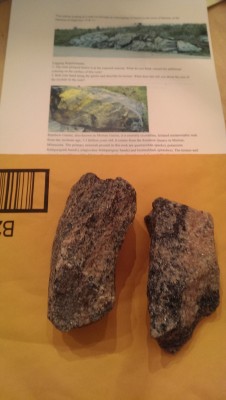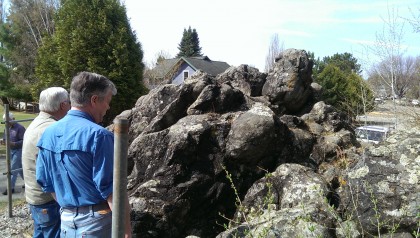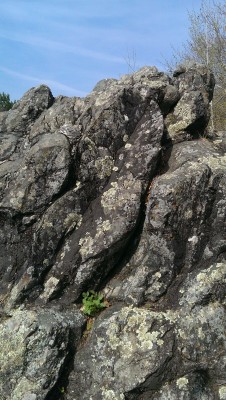Beltane Beltane Moon
 There’s history, pre-history, then there’s a really, really long time ago. Friend Tom Crane sent these two chunks of Morton gneiss.* I think he wanted me to have a marker stone for the oldest rock in the U.S. Thanks, Tom. They’ve gone on the rock wall before the Ely greenstone** we collected last week.
There’s history, pre-history, then there’s a really, really long time ago. Friend Tom Crane sent these two chunks of Morton gneiss.* I think he wanted me to have a marker stone for the oldest rock in the U.S. Thanks, Tom. They’ve gone on the rock wall before the Ely greenstone** we collected last week.
We visited the Ely greenstone outflow in Ely together last Sunday after the Woolly retreat.
The ability to touch this hardened time is a remarkable opportunity. The past is always with us.
Our body is the Morton gneiss of our deep past. It carries in itself memories of formative events we have long forgotten. There is a debate about the continuity of the self, one side seeing it as a narrative stitched together to explain our existence, but non-essential. The other side, my side, sees the self as a current manifestation of all the moments that have shaped us, plus an ineffable emergent quality that makes us more than the sum of our parts.
The dense, hard bones of mother earth support the efflorescence that is the biosphere. This living, breathing outer layer is, likewise, an emergent property. It is not, said another way, predictable from the original constituent elements of planet formation. Thus, the entirety of earth’s vital children evidence the earth’s own selfhood.
This is not the gaia hypothesis which sees the earth as an interdependent system of systems. It is, rather, an attempt to position the evolution of our planet from Hadean times, the earliest period of earth’s formation, as a mystery, yet one with known parts.
The mystery is that these parts formed at all from the detritus of the big bang. The mystery only deepens as evolution proceeds and creates a wanderer that follows a repetitive path. As geologic changes shaped the early continents and reshaped them, another, profoundly deeper mystery occurred. Somehow, life. From inert gneiss and greenstone and all the other truly ancient bones, came a quickening in the vast waters that covered most of the surface.
In my opinion the revealed self of this particular cosmic location manifests in this most peculiar change, one in which the earth begins to move, root, swim, run, think. I am not trying to anthropomorphize the earth. It doesn’t need it. It is as it has become, a thing sui generis, unique in our solar system, maybe in our galaxy. Who knows?

*”Archean crystalline basement rocks are exposed at several places along the Minnesota River valley in south-central Minnesota. These rocks are mostly gneisses of various compositions along with other igneous and metamorphic rocks.
 |
Left: exposure of mafic gneiss at Granite Falls beside the Minnesota River. Right: closeup view of pegmatite vein within the gneiss at Granite Falls. |  |
Among these ancient rocks, the Morton and Montevideo gneisses are the oldest whole-rock continental crust in the United States. Many attempts to date these rocks using various radiometric techniques have yielded an age ~3.5 billion years old (Goldich, Hedge and Stern 1970; Bickford Wooden and Bauer 2009).” Morton gneiss

**”The lakes of the BWCA were carved from Precambrian bedrock of the Canadian Shield by advances of ice sheets during a succession of ice ages during the past two million years. Many varieties of this ancient bedrock are exposed, including granite, basalt, greenstone, gneiss, as well as metamorphic rocks derived from Precambrian volcanic and sedimentary rocks. Greenstone located near Ely, Minnesota is up to 2.7 billion years old. The size and shape of most lakes in the BWCA are dictated by the bedrock, due to the ability of glacial ice to erode softer and weaker rocks more easily, creating depressions later filled with water.” canoetrip.com

Normally I do not read post on blogs, however I wish to say that this write-up very forced me to take a
look at and do it! Your writing style has been surprised me.
Thanks, very nice article.